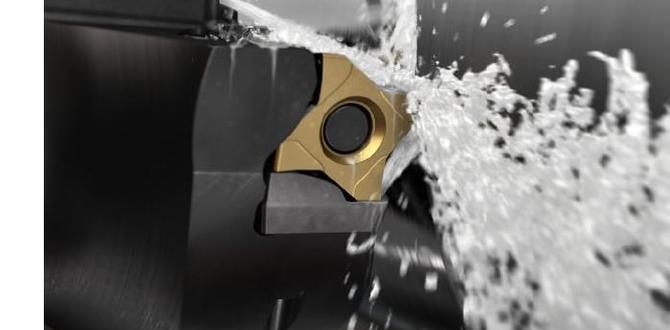A 1/8 inch carbide end mill can achieve a mirror finish on stainless steel by using the right speeds, feeds, and a high-quality tool. Proper setup, gentle entry, and avoiding excessive heat are key for that sought-after professional look, even with this small, precise tool. Let’s get that beautiful finish!
Mastering the 1/8 Inch Carbide End Mill for a Mirror Finish on Stainless Steel
Hey there, fellow makers! Daniel Bates here from Lathe Hub. Ever look at a perfectly finished piece of stainless steel and wish you could achieve that kind of shine in your own workshop? It’s totally achievable, but getting a mirror finish with a tiny 1/8 inch carbide end mill on something as finicky as stainless steel can feel like a puzzle. Stainless isn’t the easiest material to machine – it’s tough, gums up easily, and can quickly turn a shiny surface into a rough, scratchy mess. But don’t worry! With the right approach, even this small but mighty tool can deliver that professional, gleaming result you’re aiming for. We’ll break it down step-by-step, making it simple and safe. Get ready to impress yourself with what you can create!
Why Choose a 1/8 Inch Carbide End Mill for Stainless Steel?
So, why the fuss about a 1/8 inch carbide end mill for stainless steel? This size is fantastic for precision work, intricate details, and smaller projects where larger tools would be overkill. Carbide itself is a superstar material for machining tougher metals like stainless steel because it’s incredibly hard and can withstand higher temperatures than high-speed steel (HSS). This means it stays sharp longer and cuts more efficiently. A 1/8 inch size allows for fine detail work that’s just not possible with bigger cutters, making it ideal for hobbyists and professionals who need to engrave, slot, or create detailed features on stainless steel parts. Plus, when you pair it with a machine setup that’s just right, it can leave a remarkably smooth surface.
Understanding Stainless Steel’s Machining Challenges
Before we dive into the how-to, it’s important to understand why stainless steel plays by its own rules. Unlike milder steels or aluminum, stainless steel has a few tricky characteristics:
- Work Hardening: As you cut into it, stainless steel actually gets harder on the surface you’re machining. This means your tool has to keep cutting into fresh, harder material, which can dull tools quickly if not managed.
- Low Thermal Conductivity: It doesn’t dissipate heat very well. This means the heat generated by friction stays concentrated at the cutting edge, which can lead to rapid tool wear and a poor finish.
- Gummy Texture: Stainless steel can be “gummy,” meaning chips tend to stick to the cutting tool rather than breaking off cleanly. This is bad news for surface finish and tool life.
- Toughness: It’s simply a strong, tough material, requiring more cutting force.
These factors mean we need to be smart about our approach, especially when aiming for that elusive mirror finish. It’s not impossible; it just requires attention to detail and the right technique.
Tools and Setup: The Foundation for a Flawless Finish
Getting a great finish starts long before the end mill touches the stainless. You need the right gear and a stable setup. Here’s what you’ll need:
Essential Equipment:
- High-Quality 1/8 Inch Carbide End Mill: Look for end mills specifically designed for stainless steel. Often, these will have a higher number of flutes (like 3 or 4) and a specific coating (like TiAlN or AlTiN) that helps with heat resistance and lubricity. A 10mm shank is common for this size and provides good rigidity. Standard length is usually fine for most finishing passes.
- CNC Mill or Milling Machine with Rigid Setup: For the best results and control, a CNC mill is ideal. However, a very rigid manual mill can also work. The key is rigidity. Any vibration or flex will kill your finish.
- Robust Workholding: Your stainless steel workpiece needs to be clamped down securely. Vises, custom fixtures, or clamps should be used. Make sure the workpiece cannot move AT ALL during the cut.
- Coolant or Cutting Fluid: Essential for stainless steel! A good quality cutting fluid specifically for stainless steel will help lubricate the cut, flush away chips, and keep temperatures down. Soluble oil or synthetic coolants are common choices.
- Micrometer/Calipers: For accurate measurements.
- Safety Glasses and Face Shield: Always! Machining generates chips and debris.
- Gloves: Nitrile gloves can help keep oil off your hands and prevent transferring oils to the workpiece, which can affect the finish.
Setting Up for Success:
Think of your setup as the stage for a performance; everything needs to be perfect for the show to go well. Here’s how to prep:
- Secure Your Workpiece: Clamp your stainless steel material firmly. Ensure it’s perfectly flat and stable. If you’re working with a thin piece, consider using a solid backing plate.
- Tool Holder Rigidity: Use a high-quality tool holder, preferably a shrink-fit or a well-maintained collet chuck. A standard R8 collet setup can work if it’s clean and doesn’t have excessive runout. The goal is to minimize runout (wobble) of the end mill.
- Install the End Mill: Insert the 1/8 inch carbide end mill into the tool holder. Ensure it’s seated correctly and tightened securely. Leave an appropriate amount of flute length exposed – generally, you don’t want to expose more than 3-4 times the diameter for rigidity, so about 0.375 to 0.5 inches (9.5mm to 12.7mm) of flute exposure is a good starting point for this size.
- Coolant Delivery: Position your coolant nozzle so it directly targets the cutting zone. A steady stream is crucial.
- Zero Your Axes: Accurately establish your X, Y, and Z zero points.
Optimizing Speeds and Feeds for a Mirror Finish
This is where the magic happens, and it’s often about finding that sweet spot. For stainless steel and a small 1/8 inch end mill, we need to be conservative but effective.
Understanding Surface Speed vs. Rotational Speed:
End mills are rated for their surface speed in surface feet per minute (SFM) or meters per minute (m/min). This is the speed at which the cutting edge is moving. Your machine’s spindle speed (RPM) is what you control. You need to convert the recommended SFM for the material and tool into an RPM.
Formula: RPM = (SFM 3.82) / Diameter (in inches)
Or for metric: RPM = (m/min 1000) / (π Diameter in mm)
For a 1/8 inch (0.125 inch or ~3.175mm) carbide end mill in stainless steel, a common starting SFM range for finishing is around 200-300 SFM (60-90 m/min). A generally safe starting point for the finish cut might be lower.
Recommended Speeds and Feeds for a Mirror Finish (Starting Points):
These are starting points. You’ll likely need to adjust based on your specific end mill, machine rigidity, coolant, and the exact alloy of stainless steel.
Tool Material: Carbide (Coated, AlTiN or TiAlN)
Material: Stainless Steel (e.g., 316, 304)
End Mill Diameter: 1/8 Inch (3.175 mm)
Shank Diameter: 10mm
Length: Standard
Number of Flutes: 3 or 4
| Operation | Spindle Speed (RPM) | Feed Rate (IPM) | Depth of Cut (DOC) | Width of Cut (WOC) | Chip Load per Flute |
|---|---|---|---|---|---|
| Finishing Pass (for Mirror Finish) | 4000 – 8000 RPM | 5 – 15 IPM (0.13 – 0.38 mm/rev) | 0.001 – 0.005 inches (0.025 – 0.127 mm) | 0.010 – 0.030 inches (0.25 – 0.76 mm) | 0.0005 – 0.0015 inches (0.013 – 0.038 mm) |
| Light Roughing/Pre-finishing (if needed) | 3000 – 6000 RPM | 8 – 20 IPM (0.20 – 0.51 mm/rev) | 0.010 – 0.020 inches (0.25 – 0.51 mm) | 0.040 – 0.080 inches (1.0 – 2.0 mm) | 0.001 – 0.002 inches (0.025 – 0.051 mm) |
Notes on Speeds & Feeds:
- Chip Load: This is critical. Chip load is the thickness of the material removed by each cutting edge per revolution. For a mirror finish, you want a very small chip load. The formula for chip load is: Chip Load = Feed Rate / (RPM Number of Flutes). For a mirror finish, aim for a very light chip load, often in the range of 0.0005 to 0.0015 inches per tooth.
- Depth of Cut (DOC): For finishing, you want a very shallow DOC. This minimizes the cutting forces and heat generated, allowing the tool to skim the surface.
- Width of Cut (WOC): For a mirror finish, a light WOC is also beneficial. This ensures the entire cutting edge is engaged but not overloaded.
- Listen to Your Machine: The sounds your machine makes are your best indicator. A smooth, consistent hum is good. Any chattering, screaming, or knocking means your speeds, feeds, or setup are off.
- Start Conservatively: Always start with the lower end of the recommended ranges and gradually increase if the machine sounds happy and the finish improves.
Step-by-Step Guide to Achieving a Mirror Finish
Now, let’s put it all together and machine that beautiful surface.
Preparation is Key:
- Ensure your workpiece is scrupulously clean. Remove any oil, dirt, or burrs.
- Verify your end mill is sharp and undamaged.
- Double-check your workholding and tool setup for rigidity.
- Apply coolant to the work area.
Machining Process:
- Set Z-Zero: Carefully touch off your Z-axis on the surface you intend to finish. This is critical for controlling your depth of cut.
- Ramp In (If Possible): Instead of plunging straight down, use a helical or linear ramp to enter the material. This reduces shock on the end mill. If ramping isn’t an option, use a very shallow plunge feed rate.
- Initiate the Cut: Start your spindle at the programmed RPM. Apply the programmed feed rate.
- Machining Strategy:
- For a large flat surface: Use a stepping strategy with a very light depth of cut (0.001″ – 0.005″) and a moderate width of cut (e.g., 0.020″ – 0.040″). It’s often better to take multiple light passes than one heavy one. Ensure each pass slightly overlaps the previous one to avoid witness lines.
- For a slot or pocket: Use standard pocketing routines but with extremely light DOC and WOC. Maintain consistent feed rates throughout.
- Maintain Coolant Flow: Ensure a continuous, abundant flow of coolant to the cutting zone throughout the entire operation. This is non-negotiable for stainless steel.
- Observe and Listen: Pay close attention to the sound and vibration of the machine. If you hear chattering, reduce the feed rate slightly or increase the spindle speed. If the tool seems to be rubbing or the finish is poor, check your chip load and DOC.
- Take Shallow Passes: For a mirror finish, your final one or two passes should be extremely shallow (0.001″ or less) and at a slightly slower feed rate than your initial finishing passes. This “polishes” the surface.
- Continuous Machining: Avoid stopping and starting the spindle mid-cut if possible. Continuous motion helps maintain a consistent surface finish.
- Clear the Area: Once machining is complete, stop the spindle and allow chips to clear before retracting the tool.
Post-Machining:
Once the part is clear of the machine:
- Clean Thoroughly: Wash the part immediately with a degreaser to remove all coolant and metal fines.
- Inspect: Examine the surface under good lighting. You should see a reflective, mirror-like finish with minimal or no visible tool marks.
- Deburr (if necessary): Use a fine deburring tool or a specialized deburring blade to gently remove any small burrs, being careful not to scratch the finished surface.
Troubleshooting Common Issues
Even with the best intentions, things can go wrong. Here’s how to tackle them:
- Chattering/Vibration:
- Cause: Too aggressive feed/DOC, loose workholding, worn tool, excessive tool overhang, machine spindle issues.
- Fix: Reduce feed rate, reduce DOC, ensure workholding is rock solid, use a shorter tool overhang, check for spindle runout.
- Poor Surface Finish (Scratchy/Dull):
- Cause: Inadequate coolant, dull tool, incorrect speeds/feeds (too high a feed rate, too low RPM, creating a “rubbing” action), work hardening, contamination.
- Fix: Increase coolant flow, use a fresh/sharp tool, adjust speeds/feeds to achieve proper chip load, take shallower finishing passes, ensure workpiece is clean.
- Chips Welding to the Tool (Galling):
- Cause: Insufficient coolant, incorrect speeds/feeds (feed too low, leading to rubbing), poor chip evacuation, too high a cutting speed.
- Fix: Use more coolant, adjust feed and RPM to encourage proper chip formation, ensure good chip evacuation paths, try slightly slower cutting speeds.
- Tool Breakage:
- Cause: Excessive feed rate, too deep DOC, plunging into the material too aggressively, dull tool, interrupted cuts, poor rigidity.
- Fix: Reduce feed, reduce DOC, use ramp entry, ensure tool is sharp, avoid interrupted cuts where possible, improve rigidity.
The 1/8 Inch Carbide End Mill for Stainless Steel: Pros and Cons
Like any tool, our little carbide end mill has its strengths and weaknesses when tackling stainless steel.
Pros:
- Precision Detail: Excellent for intricate designs, small features, and engravings.
- High-Quality Material: Carbide offers superior hardness and heat resistance for tougher materials.
- Achievable Mirror Finish: With the right settings, it can produce excellent surface finishes.
- Good for Small Projects: Ideal for hobbyists and those working on smaller components.
- Cost-Effective for Specific Tasks: Very efficient for detailed finishing work.
Cons:
- Tool Life: Can be lower than larger tools if pushed too hard or if feeds/speeds are incorrect on stainless.
- Rigidity Limitations: Being small, it’s more susceptible to vibration if the setup isn’t perfectly rigid.
- Heat Dissipation: Small diameter means less mass to absorb heat, so coolant is critical.
- Slower Material Removal: Not suited for heavy roughing of large areas.
Maintaining Your Carbide End Mill
To keep getting that stellar finish, your end mill needs care. While carbide is tough, it’s also brittle. Treat it






